Buy a 1911 on GunsAmerica: https://www.gunsamerica.com/Search.aspx?T=1911
If I were to choose the most critical component of accurate shooting, regardless of whether you’re shooting fast or slow, it would be trigger control. Everything else we practice–stance, grip and other body mechanics–ultimately serves one purpose: to keep the gun steady and avoid disturbing the sights while depressing the trigger.
Let’s get to the core of the issue, which is the fact that the trigger in a handgun requires more force to depress than the loaded gun weighs. This means that the gun will move before the trigger does, unless action is taken to prevent that movement. Now that we have identified the problem, let’s look at some tools that can help.
“Where on the finger” depends on your finger
There are three positions on the finger that can be placed at the center of the trigger.
- The tip of the pad
- The middle of the pad
- The first distal joint.
There are as many different hand and finger sizes and shapes as there are handguns. One size does not fit all. Heck, one size probably won’t work well for most, but we learn to make do with what we have. We can learn to make almost anything work, given enough effort. There are many reasons to practice proper finger placement, and I will try to cover most of them below.
[one_half]
[/one_half][one_half_last]
[/one_half_last]
Straight back vs pivoting
[full_width] [/full_width][one_half]
[/full_width][one_half]
You should use the movement of the second distal joint to depress the trigger, as this results in a straight back motion. The opposite of this is to use the proximal phalanx, which pulls the trigger with a hooking motion. Too much finger in the trigger guard will result in this hooking, which pushes the barrel low and to the left. This will also cause additional gun movement when the tendons in between the proximal phalanx and Middle phalanx contract and bulge. [/one_half][one_half_last]
[/one_half_last]
Smooth vs “feel everything”
My whole life I have been taught the mantra “smooth, steady trigger.” I can tell you from experience that most triggers are not smooth. They have take-up and rough spots, and the pressure builds as the trigger moves to the rear. My only recourse is to embrace these flaws and continue to apply pressure. I want to feel all of these catches and clicks; it’s like feeling the road under a great sports car. If you don’t feel these imperfections, you are using too much force on the trigger.
[one_half]
[/one_half][one_half_last]
[/one_half_last]
Least amount of pressure possible
I know that a GLOCK out of the box has a 6.5 pound trigger (measured at the foot). When firing one, my goal is to use only 6.6 pounds of pressure. Using less force increases your chances for quick and accurate shots. The dominant index finger on most males is capable of applying well over 20 pounds of pressure. I have seen triggers damaged from too much pressure.
[one_half]
[/one_half][one_half_last]
[/one_half_last]
Light is Fast
When I want to shoot fast, I know that my natural tendency is to use too much force. This results in what has been called “trigger freeze.” Trigger freeze is a condition in which the shot is fired, and you think you have allowed the trigger to reset, but when you depress the trigger again the gun does not fire. When such excessive force is used, and the index finger compresses against the trigger, a sensation of movement is caused when the finger decompresses, although the trigger itself has not moved far enough to reset.
Reset
Trigger Reset is a term used to describe the distance the trigger moves back toward its “at rest” position before it re-engages the internal linkages (sear, etc.) that allow the gun to be fired again
In class, I will have students fire a shot and hold the trigger all the way to the rear afterwards. Then I have them slowly release the trigger until they hear the “click” and feel it in their trigger fingers. When that happens, the sear has reset, and another shot can be fired by pulling the trigger to the rear again.
[one_half]
[/one_half][one_half_last]
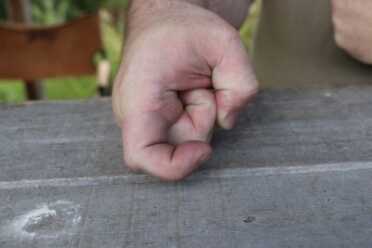
This is an excellent “at home” drill that will help to emphasize the fundamentals. Bring it straight back–no hook!
[/one_half_last]
Final Thoughts
I would recommend that you try each of these methods; your results may vary. I would also encourage you to try practicing the Weaver, Chapman and Isosceles stances. Your finger placement on the trigger will depend largely on which gun you are shooting. When I shoot a double action revolver, I almost always use the first distal joint. I will typically touch with the center of my pad when firing a GLOCK, while a good 1911 will get the tip of the pad. As always, remember to take it slow and be safe!




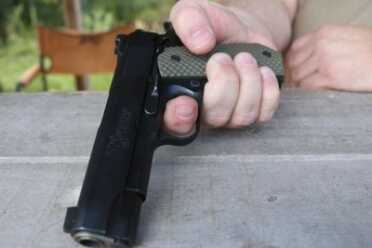
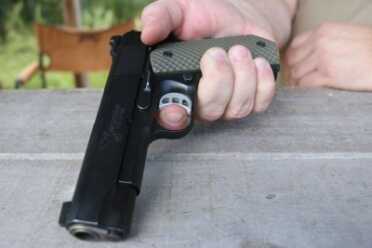
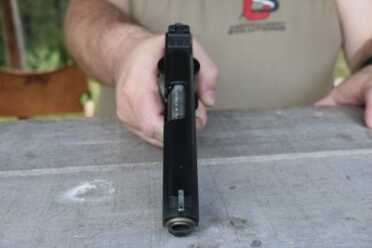
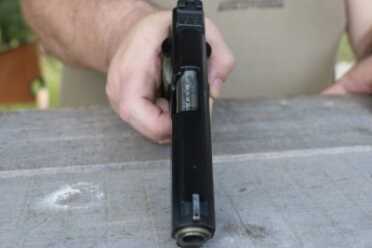
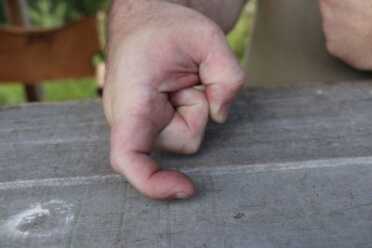
Thanks for the clear description! Makes good sense. I just graduated from the world of DAO revolvers and pocket pistols to the amazing world of Mr. Browning’s genius last year, and I suspect never to return: I am having some self-training issues of breaking old habits, though, with the very different trigger. Your tips are well-taken, thanks!
No one understands trigger control better than NRA Bullseye (Precision) and Olympic shooters. If poor trigger control can plague two handed shooting imagine the grief it causes when only one hand is employed. Here is a drill we do to improve trigger placement and trigger control. This exercise is done one handed with only the shooting hand on the firearm.
SAFETY FIRST so unload the firearm and remove the ammunition out of reach. 1) Place the unloaded gun in your hand, gripping normally with finger off the trigger. 2) Assume your shooting stance and with eyes closed raise the gun to eye level pointed at your target. 3) Open your eyes and observe the sight alignment. If the sights are aligned or reasonably close proceed to the next step. However if the sights are not aligned reposition the gun in your grip and repeat 1-3 until you can present the gun one handed with the sights aligned. 4) Place your trigger finger on the trigger at the place that “feels” unstrained. Tendon and or muscle tension will interfere with a clean break. 5) Carefully dry fire watching the front sight closely and observing which way if any that the sight bobs when the trigger breaks. If the fronts bounces to the left a right handed shooter too little finger on the trigger so you are pushing it to the left. If the front bounces to the right a right handed shooter is hooking the trigger (too much finger) and pulling it to the right. 6) Adjust your trigger finger position until you can release a shot without disturbing the front and rear sight alignment.
7) After you have found the best position for your finger now train for consistency.
The great thing about this is that it is free, consuming only time and can be done anyplace that you can unload your firearm and work on the fundamental of trigger control. If you combine this with a target you can train for the fundamentals of position, grip, sight alignment, sight picture, and trigger control.
There are a lot of theories about what part of the trigger finger should contact the trigger but what really matters is that you can break a shot without disturbing the sight alignment and this exercise will help you realize that objective. On some guns like the 1911 you can change trigger length so you have more latitude on finger placement. For that, many of us have followed Brian Zins (google for his credentials) example and place the first joint on the trigger because we can feel it better through the sensitive thin skin and bone better than we can through a well padded first (distal) phalanx.
There is more to trigger control outside the scope of this article but imagine your confidence in your two handed live fire shooting when you can do this while holding the firearm in only one hand.
Let’s keep the ammunition and component manufacturers fully employed and do our part for the economy.
First time I shot a gun was in the U.S. Army. M-14(1967), then came the M-16. First handgun was a Berretta 96 (1996) centurion. Got a Glock 22 good gun. Then in 2000 I bought a Wilson Protector in .45APC. I became a John Moses Browning disciple ever since.
Very good coverage of this topic. Might expand breakdown of trigger contact: tip minor compression, take up: more tip compression and movement through any “slack”, compression increase to the “break”.
Shooters that practice trigger control and do not practice reset technique are wasting half their training time. Trigger reset is expedient trigger positioning in preperation for a faster follow up shot eliminating unnecessary finger movement that cause handgun instability and delay accurate fire.
Trigger reset like trigger break will vary in feel and travel distance by weapon system and even within like firearms.